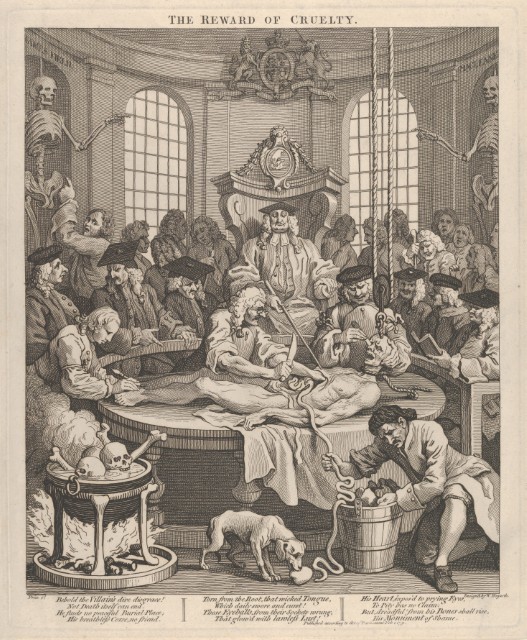 bbb
bbb
The Bloody Code and the Butcher’s Knife: How 18th Century Justice Turned Murderers into Medical Specimens
18th century criminal justice in Britain was notorious for its brutality. It was the time of the Bloody Code, where over two hundred crimes were punishable by hanging. Even relatively minor crimes, such as petty theft, could still land you in the gallows.
Perhaps the best example of this brutality was the Murder Act of 1751, which demanded the dissection of murderers after their hanging. This might seem like a shocking punishment to us today, but in the mid-18th century, the British government thought it was not only good but necessary. Murder cases at the time were haphazard. Judges had significant discretion in their cases, and so lesser convictions were common, as were pardons, conditional pardons, and reprieves.
Furthermore, the fact that the punishment for murder was hanging – the same as for numerous minor crimes during the time – made it seem like the crime didn’t have the legal infamy it deserved. This was compounded by a spike in murders in the 1750s, which the press latched onto with great hysteria. One such murder case was likely that of Mary Blandy, a young heiress who had poisoned her own father following a botched engagement.
The spike in paranoia by the public was accompanied by another problem, a lack of bodies. With medical science becoming increasingly important during the century, cadavers were needed – but few, if any, were available. Dissection was seen as an act that would deny someone a proper churchyard burial, so very few were available for such work. Bodies were still needed, though, and as murderers were seen as guilty of a far greater crime than most, their punishment could be made much more severe.
The Murder Act of 1751 included a number of measures to solve both problems. Executions were to be done only two days after a murder conviction was announced, the discretion of judges was limited, and bodies had to be handed over to medical authorities to be dissected or hung in chains to rot. This would ensure a supply of bodies for medical science while also creating an additional stigma around murderers so great that it would discourage future crimes. The act passed swiftly through parliament with little objection and became law at Easter 1752.
From then on, most murderers were swiftly punished with hanging and dissection. To be hung in chains was considered a lesser punishment, and in Oxford, dissection was in heavy demand due to the university. The Ashmolean was used as the grounds for such events, and then most bodies returned to the castle to be buried.
Mary Blandy would not be dissected. Her conviction in March 1752 was just before the act was put into effect. However, she may have still been affected by the act at her hanging. Following her death, no coffin had been made ready, so as a result, her body was carried off in a “beastly manner,” as one source put it. It is possible that the executioner, unsure how to react to the new legislation, didn’t know what to do and did not prepare a coffin as it would have been illegal to do so for a murderer.
Others would not share Mary’s kinder fate. Giles Covington was executed at Oxford Castle in 1791 for highway robbery. His body was dissected and then used in medical studies for decades afterward. In 2002, as excavations were being done at the castle grounds, several skeletons were found with obvious signs of dissection, including craniotomies, missing limbs, and, in one case, a full decapitation!
In the end, the act’s effectiveness was dubious, and the demand for bodies by medical students was not satiated by it. However, it remained on the books until 1832, creating a strong connection between murder and medical dissection.
You can come and hear more about the life of Mary Blandy, as well as other peculiarities of 18th century criminal justice, on our Guided Tours!


| Cookie | Duration | Description |
|---|---|---|
| cookielawinfo-checkbox-advertisement | 1 year | Set by the GDPR Cookie Consent plugin, this cookie is used to record the user consent for the cookies in the "Advertisement" category . |
| cookielawinfo-checkbox-analytics | 11 months | This cookie is set by GDPR Cookie Consent plugin. The cookie is used to store the user consent for the cookies in the category "Analytics". |
| cookielawinfo-checkbox-functional | 11 months | The cookie is set by GDPR cookie consent to record the user consent for the cookies in the category "Functional". |
| cookielawinfo-checkbox-necessary | 11 months | This cookie is set by GDPR Cookie Consent plugin. The cookies is used to store the user consent for the cookies in the category "Necessary". |
| cookielawinfo-checkbox-others | 11 months | This cookie is set by GDPR Cookie Consent plugin. The cookie is used to store the user consent for the cookies in the category "Other. |
| cookielawinfo-checkbox-performance | 11 months | This cookie is set by GDPR Cookie Consent plugin. The cookie is used to store the user consent for the cookies in the category "Performance". |
| PHPSESSID | session | This cookie is native to PHP applications. The cookie is used to store and identify a users' unique session ID for the purpose of managing user session on the website. The cookie is a session cookies and is deleted when all the browser windows are closed. |
| viewed_cookie_policy | 11 months | The cookie is set by the GDPR Cookie Consent plugin and is used to store whether or not user has consented to the use of cookies. It does not store any personal data. |
| Cookie | Duration | Description |
|---|---|---|
| _ga | 2 years | The _ga cookie, installed by Google Analytics, calculates visitor, session and campaign data and also keeps track of site usage for the site's analytics report. The cookie stores information anonymously and assigns a randomly generated number to recognize unique visitors. |
| _gat_UA-9822230-4 | 1 minute | A variation of the _gat cookie set by Google Analytics and Google Tag Manager to allow website owners to track visitor behaviour and measure site performance. The pattern element in the name contains the unique identity number of the account or website it relates to. |
| _gcl_au | 3 months | Provided by Google Tag Manager to experiment advertisement efficiency of websites using their services. |
| _gid | 1 day | Installed by Google Analytics, _gid cookie stores information on how visitors use a website, while also creating an analytics report of the website's performance. Some of the data that are collected include the number of visitors, their source, and the pages they visit anonymously. |
| CONSENT | 2 years | YouTube sets this cookie via embedded youtube-videos and registers anonymous statistical data. |
| Cookie | Duration | Description |
|---|---|---|
| _fbp | 3 months | This cookie is set by Facebook to display advertisements when either on Facebook or on a digital platform powered by Facebook advertising, after visiting the website. |
| fr | 3 months | Facebook sets this cookie to show relevant advertisements to users by tracking user behaviour across the web, on sites that have Facebook pixel or Facebook social plugin. |
| test_cookie | 15 minutes | The test_cookie is set by doubleclick.net and is used to determine if the user's browser supports cookies. |
| VISITOR_INFO1_LIVE | 5 months 27 days | A cookie set by YouTube to measure bandwidth that determines whether the user gets the new or old player interface. |
| YSC | session | YSC cookie is set by Youtube and is used to track the views of embedded videos on Youtube pages. |
| yt-remote-connected-devices | never | YouTube sets this cookie to store the video preferences of the user using embedded YouTube video. |
| yt-remote-device-id | never | YouTube sets this cookie to store the video preferences of the user using embedded YouTube video. |